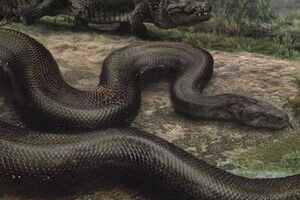Titanoboa, meaning "Titanic Boa," was a very large genus of snake that lived approximately 60–58 million years ago, during th

The Massive snake was larger and longer than a bus.
e Paleocene, a 5-million-year period immediately following the Cretaceous extinction event . The only known species is Titanoboa cerrejonensis, the largest snake ever discovered, which supplanted the previous record holder, Gigantophis. It was bigger than the Cretaceous-Paleocene snake Sanajeh.
Discovery
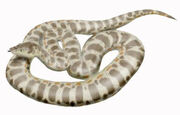
Titanoboa Would have looked like a massive green anaconda
In March 2012, mining in South America led construction workers to come across fossils from the early Paleocene Era. Among them were giant turtles, big fish, and large crocodiles. One piece of vertebrae was sent to the Smithsonian t
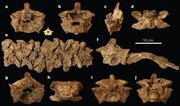
Titanoboa Fossils
hought to have been belonged to a crocodile, but a closer look at a snake expert while unwrapping the backbone proved to not be the case. Paleontologists were eager to go to South America and see what more they can uncover of this illusive snake. After several weeks of failed attempts, they finally found several
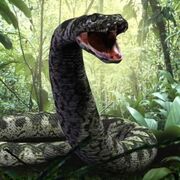
more large vertebrae and even a skull, and were able to conclude that this massive snake was by far the largest ever discovered. It was named Titanoboa cerrejonensis, for its impressive size and being found in the area of the Cerrejon jungle. A closer analysis of the skull proved that this reptile was more closely related to Boas than Anacondas, despite being so big. Many scientists have said that Titanoboa is the find of the decade, and that it's one of the most important finds since finding Tyrannosaurus rex in 1902. Not just Titanoboa was an important find, but the entire fossil site was also a great contribution to science. It revealed a new type of ecosystem in South America previously unknown to science and shows what kinds of animals ruled South America after the dinosaurs were wiped out.
Diet and feeding.
Titanoboa was one of the largest land animals of it's time, so it needed a lot of food to keep healthy. However it did not eat that often. The crocodiles of the ancient Cerrejon rainforest fell prey to Titanoboa, af

ter eating it, the snake would not have to feed for a whole year. Titanoboa was an ancestor of Boas and Anacondas, and like them it was a constrictor, but could give ten times the pressure of that from a common anaconda. Titanoboa would also eat large fish on usual occasion. Like modern-day snakes, it could also dislocate its jaws to help swallow prey bigger than its own head whole.
Paleobiology
Titanoboa was the largest snake ever discovered, measuring a max-size of about 43 feet (13 meters) long and 1.135 tonnes in weight. Although more closely related to modern-day boas, most scientists agree that thi
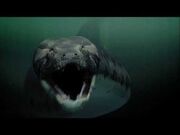
Titanoboa from Monster Snake
s monster snake behaved more like a modern-day green Anaconda, spending most of its time in water to support its massive size. Like most snakes, this snake was an expert ambush predator, capable of striking at incredible speeds at unsuspecting prey. Along with spending most of its time underwater, Titanoboa also hunted under water, since no prey capable of feeding it lived strictly on land and being a terrestrial hunter would've been damaging t
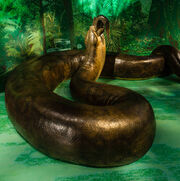
Life-Size Titanoboa Statue
o its internal organs from its massive weight. Like modern constrictors, it had a very muscular, legless body that was perfectly designed for wrapping around large prey and squeezing the life out of it. It also had a jaw that could dislocate and help swallow prey items whole that were bigger than its head. It's also likely that, when in danger from massive, 40-foot (12-meter) long crocodiles, Titanoboa could regurgitate a large meal that it had just eaten to get away. Like modern-day snakes, it also had a forked tongue that helped it locate its prey underwater.
In Popular Culture
Ever since its discovery in early 2009, Titanoboa has been gaining a lot of public attention. It had its own documentary by the Smithsonian Channel, where it talked about what this huge reptile l
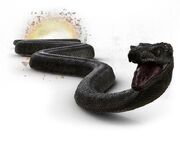
Primeval Titanoboa
ooked like, how it lived, and how its environment looked while scientists tried to further uncover it and piece it together. It even had its own entire article in the Smithsonian magazine. Titanoboa was also featured in one of the episodes of Primeval: New World, where it killed a pair of scientists on a boat and nearly killed many more. It also has its own life-size statued in an exhibit in the Smithsonian Museum. İn anothr documentary about The animal; The titanoboa is 'estimated' to everwhelm\overpower even Tyrannosaurus rex ! [1]

Titanoboa Monster Snake - Teaser
References
Websites:
http://www.smithsonianmag.com/science-nature/How-Titanoboa-the-40-Foot-Long-Snake-Was-Found.html
http://en.wikipedia.org/wiki/Titanoboa
http://news.ufl.edu/2012/12/20/titanoboa-exhibit-opens-jan-26/
http://usatoday30.usatoday.com/tech/science/story/2012-03-31/titanoboa-prehistoric-snake/53903042/1
Documentaries:
Titanoboa: Monster Snake
Magazines:
Smithsonian
